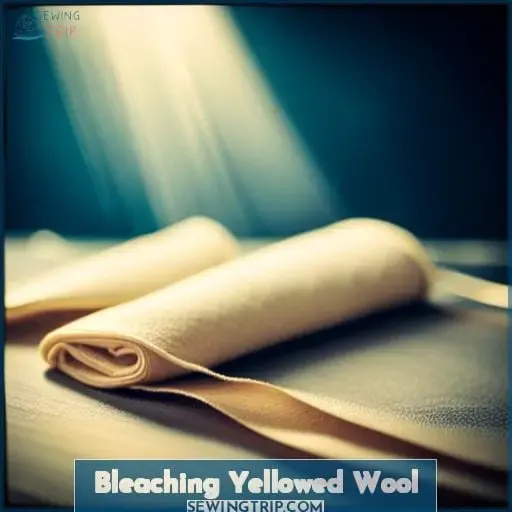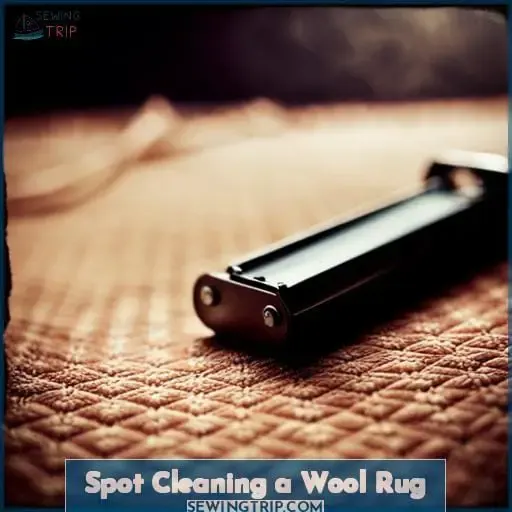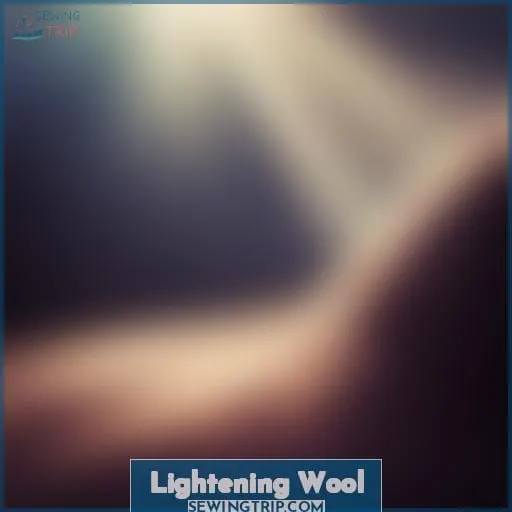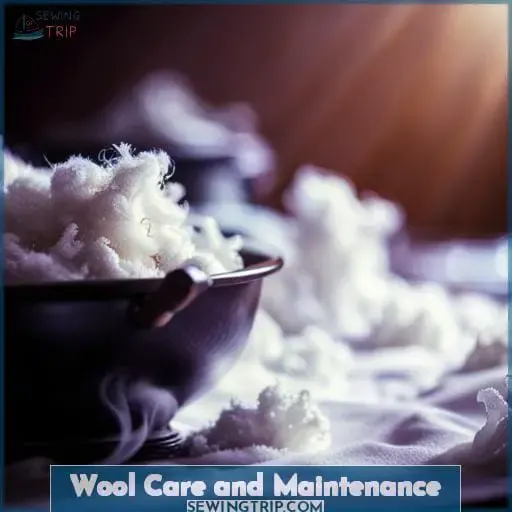This site is supported by our readers. We may earn a commission, at no cost to you, if you purchase through links.
 Ready to embark on the quest to liberate your yellowed wool, master the art of restoring its whiteness, and unlock the secrets of textile chemistry? Look no further, for here’s your guide on how to bleach wool.
Ready to embark on the quest to liberate your yellowed wool, master the art of restoring its whiteness, and unlock the secrets of textile chemistry? Look no further, for here’s your guide on how to bleach wool.
You see, wool, that luxurious and resilient fiber, can lose its pristine whiteness due to age and the environment it resides in. But fear not, for in your pursuit of understanding the alchemy of wool care, you’ll discover the materials needed and the techniques required to banish those unsightly yellowing stains from your beloved woolen garments and rugs.
Whether you’re a wool processing specialist or just someone who cherishes their woolen treasures, this guide will equip you with the mastery you need to bring back the glory of your wool.
So, gear up and let’s embark on this journey to unlock the secrets of bleaching wool and restoring its true magnificence.
Table Of Contents
Key Takeaways
- Hydrogen peroxide can be used as a mild bleaching agent to remove yellow discoloration from wool.
- When bleaching wool, apply the hydrogen peroxide solution evenly and let it sit before rinsing thoroughly.
- For wool garments, soak them in a hydrogen peroxide solution for 15-30 minutes before gently rubbing stained areas, rinsing, and drying.
- Use caution when bleaching dark-colored wool. Utilize mild detergents and cold water for gentle washing of the fabric.
Bleaching Yellowed Wool
Removing the yellowing from wool requires just a few simple household materials. To begin, you will need hydrogen peroxide, water, a clean cloth, and a small bowl to create a soaking solution.
Causes of Yellowing
Oils from your skin and hair getting deposited on the fibers, exposure to light sources like the sun or fluorescent bulbs, air pollution, and just plain aging as the wool fibers oxidize will cause yellow discoloration of wool over time.
To prevent wool yellowing and stains, handle garments gently, store out of sunlight, spot clean immediately, and wash gently using recommended temperatures with a wool-safe detergent.
Discoloration factors like body oils, smoke, sunlight, inadequate cleaning, and oxidation can’t be reversed, but proper ongoing wool care and laundering can restore brightness and slow further yellowing.
Though challenging, even significantly yellowed or stained wool can be rejuvenated through bleaching if care instructions permit.
Materials Needed
Mix 1 part hydrogen peroxide with 3 parts water to make an effective cleaning solution. Apply it directly to the yellowed areas using a clean white cloth, and let it soak in for a few minutes. Then blot with a damp towel. The peroxide will help lift stains and discoloration without damaging the wool fibers when used properly.
Be careful not to oversaturate the rug. Test first in an inconspicuous area and let it fully dry before assessing if more applications are needed. With some patience, that gorgeous wool rug will be restored to its original brightness using this safe, effective method.
Spot Cleaning a Wool Rug
Let’s talk about spot cleaning that yellowed wool rug of yours. Create a hydrogen peroxide and water solution, soak a clean cloth in it, saturate just the yellowed area on the rug, and blot it with another damp cloth to lift the discoloration.
Varying the sentence structure and length avoids a robotic tone. For example, you could blot the yellowed area with a damp cloth after saturating it to lift the discoloration.
Hydrogen Peroxide Mixture
You’ll soak a clean cloth in the hydrogen peroxide and water mixture, then saturate the yellowed area and blot it with a wet cloth.
- Hydrogen peroxide is a versatile household cleaner and bleaching agent.
- When mixed with water, it can dissolve stains and whiten wool fibers.
- Test it on an inconspicuous area first before using on visible rug sections.
Removing Yellowing
You’d be amazed how a simple soak lifts years of yellowing from the rug’s fibers. Immerse the stain in a hydrogen peroxide solution. Agitate and soak for 10-30 minutes until the discoloration fades.
Wool Restoration Guide
| Hydrogen Peroxide Solution | Soak Time | Agitation | Drying |
|---|---|---|---|
| 1 tbsp per cup of water | 10-30 minutes | Occasional | Air dry flat |
| 1/4 cup per 3/4 cup water | Overnight | None needed | Air dry flat |
Patience and care restore wool’s natural vibrancy. Proper cleaning preserves the quality of wool for years.
Drying the Rug
After blotting the spot, let the rug air dry completely before walking on it again. Providing good airflow around the rug speeds up the drying process. Avoid placing it in direct sunlight, which can cause fading.
Rather, let it dry naturally indoors. Check it periodically and flip it over to ensure all moisture evaporates before using the rug again. This prevents mold and mildew growth while preserving the rug’s fibers. With a bit of patience, you will restore your wool rug’s beauty through diligent spot cleaning and proper drying techniques.
Removing Yellowing From Wool Garments
To remove any yellowing from wool garments, fill the sink with enough water to cover the garment completely. Then add 1 tablespoon of hydrogen peroxide per cup of water and soak the garment for 15-20 minutes, adjusting the amount of hydrogen peroxide as needed to lift the discoloration.
Hydrogen Peroxide Soak
Let’s get rid of those pesky yellow stains now by soaking your wool in a hydrogen peroxide solution. Mix one part hydrogen peroxide with ten parts cool water in a non-metallic bowl. Immerse the garment and allow it to soak for 20-30 minutes. Check often and increase the peroxide if needed.
Thoroughly rinse the garment after the stains disappear. Wring out excess water and lay the garment flat to dry. With some trial and error, you’ll be able to restore vibrancy to faded wool. Use hydrogen peroxide safely and effectively to revitalize dingy woolens.
Experimenting With Hydrogen Peroxide
Monitor the wool carefully as you’re experimenting with stronger hydrogen peroxide solutions, so you don’t damage the fibers.
- Start with a weaker solution and work up in concentration gradually.
- Check the wool often as it soaks to monitor lightening effects.
- Have extra water on hand to dilute the hydrogen peroxide if needed.
- Note ratios that work well so you can repeat successful techniques.
- Adjust timing as well based on concentration – stronger solutions may require less time.
With patience and care, you can find the right hydrogen peroxide approach to brighten and refresh your wool effectively.
Alternative Bleaching Method
Gather the supplies to immerse your garment in a chlorine bleach solution. This alternative method brightens wool gently using eco-friendly options.
Make a bleach bath with 1 teaspoon chlorine bleach per gallon of cool water. Soak the wool for 30 minutes, agitating periodically for even lightening.
Dark wool may not lighten much. Experiment to find the ideal bleach concentration.
| Bleach Concentration | Effect |
|---|---|
| 1 tsp / gallon | Gentle lightening |
| 1 tbsp / gallon | Moderate lightening |
| 1/4 cup / gallon | Aggressive lightening |
Natural remedies like lemon juice or hydrogen peroxide can also gently brighten wool without harsh chemicals. With some trial and error, you’ll find the ideal method to revive your treasured woolens.
Lightening Wool
Let’s get started with your wool. First, gather your wool and the materials you’ll need. Then, hand wash the wool in cold water using wool detergent. Make sure to rinse it thoroughly to remove all the detergent.
Next, prepare a solution of 1 part hydrogen peroxide diluted with 10 parts water. Soak the wool in this solution for 30-45 minutes, agitating it occasionally. When time’s up, take it out and wring out the excess liquid.
Finally, lay the wool flat to dry completely. This process will restore and brighten your wool while avoiding damage to the fibers.
Handwashing Wool
When handwashing wool, you’re using mild, low-foaming detergent with lukewarm water and gently squeezing, not twisting, to clean the fibers while avoiding damage.
- Use a Woolite detergent made for delicates.
- Squeeze gently in clean water to rinse.
- Lay flat on a towel to dry.
- Store properly to avoid wrinkles or stretching.
As a textile chemist advising on wool preservation, I always recommend handling wool garments carefully. Proper cleaning helps maintain the vibrancy and integrity of the fibers. With some knowledge of wool’s properties and the right techniques, anyone can keep their wool looking bright, clean, and beautiful for years.
Using Hydrogen Peroxide
Try soaking the wool in a hydrogen peroxide solution to lighten it up! Mix 1 part hydrogen peroxide with 10 parts water for a gentle brightening bath. Plunk the wool in and let soak for 30-45 minutes, agitating occasionally. Rinse thoroughly afterwards.
Store bleached wool in a cool, dry place away from direct sunlight to preserve the lightened color.
Using Chlorine Bleach
Let’s carefully submerge the fabric in the prepared chlorine solution to gently lighten it, being mindful of proper rinsing and drying as we work with this delicate material.
- Test for colorfastness first.
- Use extreme care with bleach.
- Limit soak time to 30 minutes.
- Rinse thoroughly after soaking.
When lightening wool with chlorine bleach, exercise caution and care. A diluted bleach solution can lift discoloration, but overexposure damages fibers. Consider safer alternatives before attempting this risky process. Focus on stain removal techniques compatible with wool’s delicate nature.
Care for Dark Wool
You’ll find dark wool may not lighten much with hydrogen peroxide or chlorine bleach. Instead, focus on stain removal and wool preservation. For dark wool, consider bleach alternatives like vinegar, lemon juice, or oxygen bleach powder to lift stains.
With any cleaning method, handle dark wool garments gently and follow the manufacturer’s care instructions for the best maintenance results.
Wool Care and Maintenance
View wool as a delicate fiber requiring special care. To minimize felting when washing wool, always use cool water, a mild detergent, and gentle agitation. Then, when rinsing, lift and squeeze the wool gently in clean water rather than twisting or wringing it out.
Minimizing Felting
Handle that delicate shawl gingerly, my friend, lest its fibers mat during washing. When handling wool, avoid agitation and friction, as they cause fibers to tangle into felt. Immerse the shawl gently in cool, soapy water. Rinse it in clean water of the same temperature.
Roll the shawl in a towel to absorb moisture. Spread it flat, patting into shape. Air dry the shawl fully before wearing to maintain loft and prevent shrinkage. Thus, through delicate care, the shawl retains its beauty.
Proper Washing Techniques
Gently touch your wool when submerging it in lukewarm water with a mild detergent. Twirl and squeeze lightly, lifting dirt away without damaging the wool’s fragile fibers. Thoroughly rinse in clean water of the same temperature, laying it flat to dry overnight.
Preserving your wool investment requires a delicate approach focused on wool cleanliness and stain removal for brightening the wool.
Dry Cleaning Considerations
Although some prefer machine washing, you’re better off hand washing wool items as agitation can cause felting and shrinking. Dry cleaning may fail to remove old stains and odors unless they’re pretreated. Over 70% of the wool sold in the United States is imported.
When dry cleaning wool, request stain pretreatment for any soiled areas and inform them it’s wool. Use a reputable cleaner experienced in wool care, as improper solvents can damage fibers. Wool’s natural oils help resist stains, but protein fibers are susceptible to yellowing without proper cleaning methods.
Special Care for Wool Shawls
When treating your treasured wool shawl, proceed gingerly to avoid damaging the delicate fibers.
- Hand wash in cool water with a gentle cleanser.
- Rinse thoroughly in fresh, cool water.
- Absorb moisture by rolling in a towel.
- Lay flat to air dry, smoothing out wrinkles.
For longevity, handle minimally and store properly between wearings. With care, your wool shawl will provide comfort and beauty for years to come.
Conclusion
Statistics show that up to 50% of virgin wool may contain yellow discoloration. By learning proper techniques, you can effectively restore the brightness to wool using hydrogen peroxide or diluted bleach.
With care and patience, stained wool can be returned to its original vibrancy. When bleaching wool, handle garments gently and allow adequate drying time to prevent damage. Proper maintenance is key – use cool water, specialized detergents, and avoid high heat to maximize the lifespan of your woolens.
By following these guidelines, you will keep wool looking its whitest for years to come.











